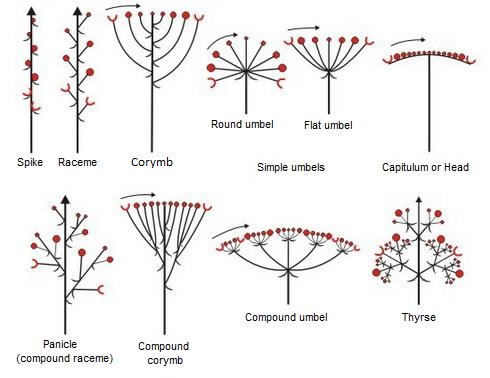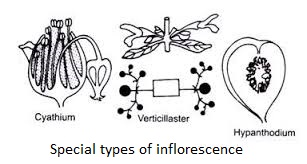
- Inflorescence is the reproductive shoot, bearing a number of flowers.
- It may be terminal or axillary in position.
- It is of two types; viz. racemose and cymose.
- Besides, there is also a special type of inflorescence which fits into none of these groups.
- Racemose inflorescence:
- In this type of inflorescence, the main axis is unlimited in growth, branched or unbranched.
- It never terminates into a flower and bears flowers in acropetal (growing upward from the base or point of attachment)
- The main types of racemose inflorescence are:
Raceme: The main elongated axis bears stalked flowers. E.g. mustard, radish, goldmohur etc.
Spike: This is like raceme but flowers are sessile or unstalked. E.g. adhatoda, chaff-flower (Achyranthes).
Catkin: This is like spike but differs from the later in having a long and pendulous axis, usually bearing unisexual flowers. E.g. mulberry, cat’s tail (Acalypha sanderiana).
Spadix or thyrse: This is a spike with fleshy axis enclosed by one or several large and brightly colored bracts, called the E.g. banana, aroids (Colocosia).
Corymb: Here, the axis is not elongated as in the above mentioned inflorescences. It is short and bears stalked flowers in such a manner that they are placed almost at the same level. E.g. Lantana, cherry etc.
Umbel: All the flowers arise from one plant. The axis may or may not be branched, simple umbel if unbranched, compound umbel if branched. Bracts are present (involucre) at the base of the flowers. E.g. carrot, coriander etc.
Head or capitulum:
- The main axis is a flattened, more or less convex structure, the receptacle, on which the florets (small flowers) are arranged in a centripetal order.
- The whole inflorescence is surrounded by an involucre (a whorl of bracts) and bears only one or two types of flowers: inner disc florets and outer ray florets. E.g. sunflower.

2. Cymose inflorescence:
- In this type, the main axis is always limited in growth and terminates into a flower.
- They are usually stalked, and borne in a basipetal (growing downward towards the base or from the point of attachment) order.
- The main types of cymose inflorescence are:
Monochasial cyme:
- The main axis terminates into a flower and one lateral branch axis develops from its base which also ends in a flower.
- There are two types of monochasial cyme:
- Scorpioid type in which the lateral branches of the axis bearing a terminal flower alternate as in Rananculus bulbosus.
- Helicoid type in which each lateral branch bearing a terminal flower develops on the same side forming a helix as in Heliotropium.
Dichasial cyme: Here, two lateral branches develop on either side of the terminal flower. The lateral branches may again branch similarly. E.g. Jasmine, Dianthus
Polychasial cyme: Here, more than two lateral branches arise from the base of the apical flower. E.g. Calotropis.

3. Special types of inflorescence:
Hypanthodium:
- Here, the main axis forms a cup shaped receptacle with a small opening at the top. Flowers are enclosed within the cup in cymose groups. E.g. Ficus.
Cyathium:
- Here, the cup shaped structure is formed by the involucre.
- The reduced flowers (without perianth) are placed on a receptacle.
- There is one central female flower represented by a single pistil which is surrounded by a large number of male flowers each represented by a single statmen only.
- The stalked flowers are subtended by a bracteole. There are also nectar glands on the cup. E.g. Poinsettia.
Verticillaster:
- Here, one inflorescence consisting of two clusters develops from each of the two opposite axils of the leaves.
- Each cluster is a dichasial cyme reduced to two scorpioid.
- Flowers are sessile and appear in a false whorl or vertically around the stem. E.g. sacred basil (Ocimum sanctum).
